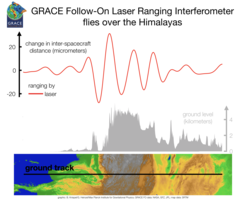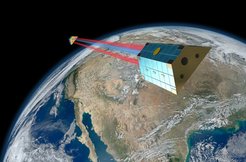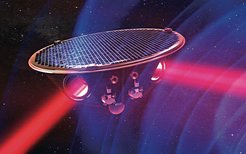First light for GRACE Follow-On laser interferometer
For the first time, laser interferometry between two satellites in space measures their 220-kilometer distance to nanometer precision
The laser ranging interferometer (LRI), a novel instrument onboard the GRACE Follow-On satellite mission, had its “first light” on 14th June 2018. An international team of researchers from the German Max Planck Institute for Gravitational Physics (Albert Einstein Institute, AEI) in Hannover, the Leibniz Universität Hannover, and the NASA Jet Propulsion Laboratory switched on their instrument and achieved success on first try. Since then, the LRI has been taking scientific measurements in parallel to the main microwave ranging instrument. Initial results agree well, and the research team is optimistic that the LRI’s improved precision will assist in tracking indicators of climate change by observing Earth’s gravity field and its variations. GRACE Follow-On is a joint project of NASA with German partners, which are led by the GFZ German Research Centre for Geosciences. The success is also an important milestone on the path towards LISA, the planned gravitational-wave observatory in space.
A mind-boggling achievement
“Even though we prepared for this moment, and calculated all the details over and over again, I only realized how outrageous it is what we wanted to do when I saw the satellites for some final measurements on the ground,” says Prof. Gerhard Heinzel, leader of the space interferometry research group at the AEI and manager of the German contribution to the Laser Ranging Interferometer (LRI). “There are these coin-sized holes on each satellite through which the laser has to be precisely pointed towards the holes in the other satellite over a distance of more than 200 kilometers while both spacecraft race around Earth at 27,000 kilometers an hour. It is truly mind-boggling!”
Therefore, the tension was high in the German Space Operations Center (GSOC) in Oberpfaffenhofen, when the research team tried to set up the laser link between the satellites for the first time after their successful launch on 22nd of May and some initial single-satellite tests. On 13th of June, the satellites swept their lasers in spiral patterns to find out if they could see each other.
Will the GRACE Follow-On satellites see each other’s laser light?
“We had worked for eight years to get to this point, so naturally we were a bit nervous. The laser instrument and its optics are quite delicate. If we had made any design mistake or if anything had been damaged during the launch, there would’ve been no way to fix it,” says Dr. Vitali Müller, a postdoc in the space interferometry research group at the AEI.
During the next night, the researchers received the good news: the spacecraft saw several split-second “flashes” during the spiral scans, meaning that the laser instruments and optics had withstood the accelerations during the rocket launch. At 3 a.m. that morning the numbers were crunched and settings to establish a continuous laser link were uploaded to the satellites soon after.
Laser Ranging Interferometer running in science mode
At 3 p.m. on 14th of June, the latest downlink from GRACE Follow-On confirmed that the LRI was running in science mode on the first attempt and was delivering its first measurements. The interferometer has been running and has been taking data continuously since then, after a brief reconfiguration the following day.

“The LRI is a breakthrough for precision measurements in space,” says Dr. Kirk McKenzie, who manages NASA's contribution to the instrument. “It’s the first inter-spacecraft laser interferometer and the culmination of about a decade of NASA and German funded research and development.”
Initial tests of the data show that they look as expected and agree very well with the data from the main microwave ranging instrument. In the coming weeks and months, the research team will work on completing their understanding of the novel laser instrument and the data it delivers. They are optimistic that the LRI – a technology demonstrator for future missions – will be a valuable addition to the main microwave ranging instrument and improve GRACE Follow-On’s mission results.
Observing climate change indicators from Earth orbit

The GRACE Follow-On satellite pair circles the Earth 490 kilometers above its surface. The satellites follow one another in a distance of 220 kilometers in a 90-minute orbit, which takes the satellites above the Earth’s poles. The inter-satellite distance varies over some hundreds of meters each orbit because of the flattening of the Earth. On top of these large changes are much smaller variations in the micrometer and nanometer range, caused by the local structure of Earth’s gravity field from mountain ranges, ice masses, bodies of ground water, and others.
Observing how these minuscule variations change over the course of months allows researchers to precisely detect the melting of ice sheets in Greenland and the Antarctic, rising sea levels, changing groundwater levels, droughts and floods, and to define the geoid, which is at the base of global height measurements. The novel Laser Ranging Interferometer technology could significantly increase the precision on future GRACE Follow-On like missions to help those missions provide more detailed measurements of Earth’s gravity field and its changes over time.
A major milestone on the way towards LISA

The GRACE Follow-On Laser Ranging Interferometer is the second space-borne laser interferometer with significant contributions from the Max Planck Institute for Gravitational Physics (Albert Einstein Institute) and Leibniz Universität in Hannover, Germany. The first such instrument was a 40-centimeter instrument on board the LISA Pathfinder mission, which showed the key technologies for LISA, the future gravitational-wave observatory in space.
“The successful laser link over 220 kilometers in space between two satellites in an Earth orbit is a major milestone on the way towards LISA, the future gravitational-wave observatory in space,” says Prof. Karsten Danzmann, director at the Max Planck Institute for Gravitational Physics (Albert Einstein Institute) in Hannover and director of the Institute for Gravitational Physics at Leibniz Universität Hannover. “After its launch in 2034 LISA will use very similar technologies to measure tiny length changes over a distance of 2.5 million kilometers. This way we will detect low-frequency gravitational waves from millions of binary stars, merging supermassive black holes, and other exotic objects.“














